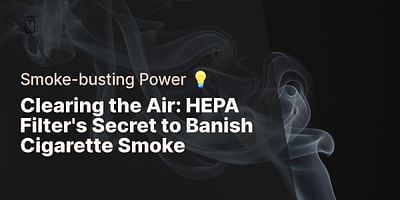Victoria is a qualified air quality expert boasting over a decade of professional experience in the field. She harbours a deep passion for enhancing the quality of air people breathe and takes pride in imparting her extensive knowledge through writing and public speaking. Victoria's expertise is a valuable resource for Air Purifier Inc.
As an air quality specialist, I often get asked whether HEPA filters can be cleaned and reused. The short answer is: it depends on the type of HEPA filter you have. There are two main types of HEPA filters: permanent or washable and disposable or replaceable. Let's dive into the details of each type and how to properly maintain them.
Permanent or Washable HEPA Filters
Permanent or washable HEPA filters are designed to be cleaned and reused multiple times. These filters are typically made of a durable material like polypropylene, which can withstand the cleaning process. To clean a washable HEPA filter, follow these steps:
1. Turn off and unplug your air purifier.
2. Remove the filter from the air purifier according to the manufacturer's instructions.
3. Use a soft brush to gently remove any visible debris from the filter. Be careful not to damage the delicate filter fibers.
4. Rinse the filter under lukewarm water, gently rubbing the surface to remove any remaining dirt. Do not use any cleaning agents or detergents, as they can damage the filter.
5. Allow the filter to air dry completely before reinstalling it in the air purifier. This may take several hours or even a full day, depending on the humidity in your environment.
Keep in mind that even washable HEPA filters have a limited lifespan and will eventually need to be replaced. Check the manufacturer's recommendations for how often to replace the filter, and be sure to monitor its performance to ensure optimal air purification.
Disposable or Replaceable HEPA Filters
Disposable or replaceable HEPA filters, on the other hand, are not designed to be cleaned and reused. These filters are made of a more delicate material, like glass fibers, which can be easily damaged during the cleaning process. Attempting to clean a disposable HEPA filter can result in reduced filtration efficiency and even damage to your air purifier.
For disposable HEPA filters, it's essential to replace them according to the manufacturer's recommendations, which is typically every 12-18 months. However, this can vary depending on factors like air quality and usage. Regularly inspect your filter for signs of wear or damage, and replace it sooner if necessary.
In conclusion, whether you can clean and reuse a HEPA filter depends on the type of filter you have. If you're unsure which type of filter your air purifier uses, consult the user manual or contact the manufacturer for clarification. Proper maintenance of your HEPA filter is crucial for ensuring optimal air purification and extending the life of your air purifier.
Comparison of Permanent/Washable and Disposable/Replaceable HEPA Filters
| Type of HEPA Filter | Material | Maintenance | Lifespan | Replacement Frequency |
|---|---|---|---|---|
| Permanent/Washable HEPA Filter | Polypropylene | Can be cleaned and reused. Should be gently brushed and rinsed under lukewarm water. Must be air dried completely before reinstallation. | Limited lifespan. Performance should be monitored for optimal air purification. | Depends on manufacturer's recommendations and filter's performance. |
| Disposable/Replaceable HEPA Filter | Glass Fibers | Cannot be cleaned. Attempting to clean can damage the filter and reduce filtration efficiency. | Typically 12-18 months. Lifespan can vary based on air quality and usage. | Should be replaced according to manufacturer's recommendations or sooner if signs of wear or damage are visible. |















